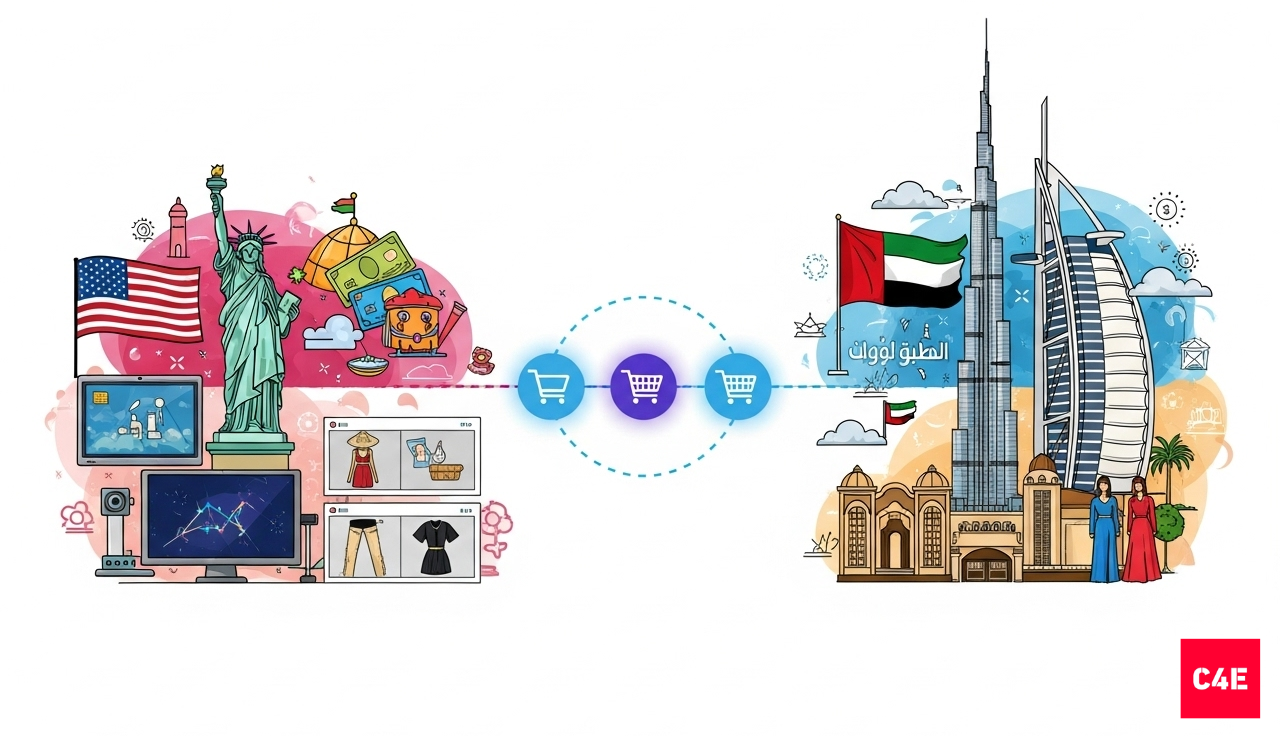
Shopify Development for US vs UAE: What Brands Need to Know
Shopify has become the world’s most trusted e-commerce platform, supporting more than 4 million businesses globally. Yet while the technology remains the same, the way Shopify is used in different markets can vary significantly.
If you are a brand considering Shopify development in the US vs the UAE, the expectations, integrations, and customer journeys are not identical.
The US is one of Shopify’s largest and most mature markets, while the UAE is an emerging hotspot for e-commerce with unique payment and cultural preferences.
Understanding these differences will help you build a Shopify store that not only functions well but also resonates with your audience.
Why Shopify Is Popular in Both US and UAE
- Global reliability: Shopify offers scalable infrastructure, trusted by enterprise brands and startups alike.
- Design flexibility: Both regions value sleek store design that reflects brand identity.
- Mobile-first approach: With most customers in the US and UAE shopping on mobile, responsive Shopify themes are crucial.
- App ecosystem: Thousands of apps allow brands to localize and customize stores without heavy coding.
While the fundamentals are the same, the way brands implement Shopify in each region reflects local consumer behavior and market maturity.
Shopify Development in the US
The US ecommerce market is highly competitive. Customers expect polished experiences, fast shipping, and easy returns. Shopify development in the US focuses on:
- Advanced Customization
Many US brands invest in custom themes and user experiences to stand out in crowded categories. Generic templates rarely perform well. - Integration With Marketplaces
Shopify stores in the US often connect with Amazon, Walmart, and eBay for multi-channel selling. Seamless integration helps brands expand reach beyond their own websites. - Subscription Models
The subscription economy is mature in the US. From meal kits to beauty boxes, Shopify development often includes recurring payment setups and subscription app integrations. - Logistics and Fulfillment
US customers demand two-day or even same-day delivery. Brands rely on integrations with Shopify Fulfillment Network, ShipBob, and other 3PL providers to meet these expectations. - Payment Preferences
While credit cards and PayPal dominate, BNPL (Buy Now Pay Later) options like Afterpay and Klarna are increasingly popular in US Shopify stores.
Shopify Development in the UAE
The UAE is one of the fastest-growing e-commerce markets in the Middle East. However, consumer expectations and behaviors differ significantly from the US. Shopify development in the UAE often emphasizes:
- Mobile-First Design
Shopify stores must be optimized for mobile-first experiences with simplified checkout flows. - Multilingual Support
Arabic and English are both essential for UAE brands. Shopify development often involves bilingual store setups to cater to local and expat audiences. - Payment Preferences
Unlike the US, Cash on Delivery (COD) remains a major payment method in the UAE. Payment gateways like Telr and Payfort are integrated alongside global options. - Cultural Sensitivity in Design
Store design and visuals often reflect local cultural norms. For example, modest fashion brands thrive in the region, and imagery must align with cultural values. - Luxury and Premium Positioning
The UAE market is known for its preference for premium products and luxury brands. Shopify store design often highlights exclusivity and high-end branding.
Cost of Shopify Development: US vs UAE
- US: Shopify development costs can range from $5,000 to $50,000, depending on customization, integrations, and scale. Agencies in the US often charge higher retainers due to mature demand and competition.
- UAE: Development costs typically range from AED 15,000 to AED 100,000. While lower than the US on average, custom bilingual stores and COD integrations add to the budget.
Both markets also incur monthly Shopify fees (starting at $39 in the US and AED-equivalent internationally), plus app and plugin subscriptions.
Case Study: Scaling in Two Different Markets
Consider two startups:
- A US-based health supplements brand built a Shopify store with recurring subscription payments and advanced analytics. Within six months, subscription revenue accounted for 40 percent of sales.
- A UAE-based fashion label launched a bilingual Shopify store with COD and WhatsApp integration. They reached rapid adoption across Dubai and Abu Dhabi, with 60 percent of orders placed via mobile.
Both succeeded, but their development priorities were entirely different.
Common Mistakes to Avoid
- US Brands: Relying on basic templates in competitive categories like apparel or electronics. Without custom design, it is difficult to stand out.
- UAE Brands: Ignoring COD or failing to support Arabic localization. These oversights immediately reduce trust and conversions.
How to Choose the Right Shopify Partner
When comparing Shopify experts in the US vs UAE, consider:
- Experience in your market: Check if the agency has built stores for similar audiences.
- Technical expertise: Ask about integrations with payment gateways and logistics partners.
- Design alignment: Ensure they can adapt visuals to local expectations.
- Support: Choose a partner that provides ongoing support beyond launch.
The Future of Shopify in US and UAE
- In the US, expect more AI-driven personalization, faster logistics, and deeper integrations with social commerce platforms like TikTok Shop.
- In the UAE, expect growth in bilingual experiences, regional payment solutions, and stronger adoption in Tier 2 Gulf markets.
Shopify development services in both regions will continue to grow, but the winning strategy is local adaptation. What works in Los Angeles may not resonate in Dubai.
Shopify’s strength lies in flexibility. Whether you are expanding in the US or launching in the UAE, your store must align with local customer behaviors, payment systems, and cultural expectations.
Choosing the right Shopify development partner ensures that your store is not just technically functional but strategically built for growth.

